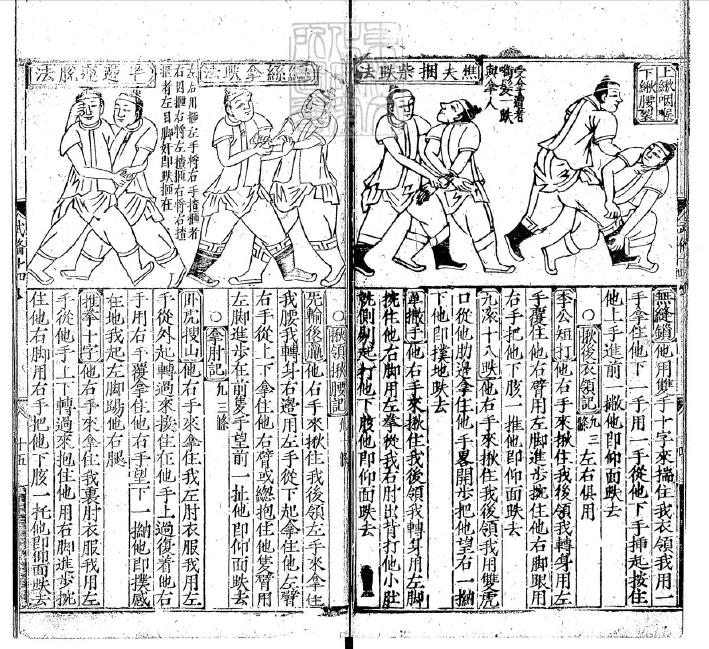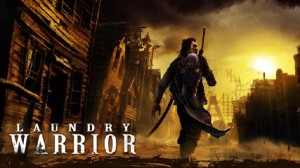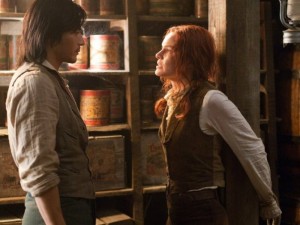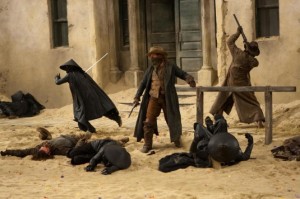Sucker Punch, A film about self-defense
/Certainly there have always been people who found ways to practice fighting and reasons for claiming their actions were righteous. But that is not the same as claiming self-defense. For instance, in China it was common to claim that one had to fight to protect ones honor or property. But what if you had no property or no honor? Theater professionals were the lowest social caste, below even thieves, clearly they had no honor to defend. Similarly Biblical justice, an eye for an eye, is framed as the settling of a score, it is not an argument for self-defense.
This is why I was so taken by Sgt. Rory Miller's arguments in Meditations on Violence. He explained that very few forms of social violence justify an act of self-defense. With a few exceptions social violence is avoidable and deterrable. Social violence is the form of violence that most people have experience with, consequently they tend to confuse it with asocial violence which is a much rarer form of violence. Asocial violence almost always requires an act of self-defense. For instance, in the international arena we hear the absurd and incomprehensible argument that Israel responds to attacks against it's civilian population with disproportionate force. This type of argument only makes sense if you believe this is a social conflict. In an asocial conflict one is expected to use the minimum amount of force necessary to neutralize the threat. In the case of Israel, it has yet to neutralize the threat, up until the threat is neutralized any level of violence is justified. Likewise in a social conflict, if we can easily retreat we are expected to do so. But you don't retreat once someone has broken into your house. Retreating from asocial violence tends to leave a trail of blood. The 1948 declaration of Jewish autonomy will continue to be an offense to all those who consider Jews less than fully human.
Bernard Lewis recently explained that there is no word for 'Freedom' in Arabic, the closest term is something a kin to 'justice.' In the recent demonstrations in Egypt people were chanting "Freedom" in English. As hopeless as it may sounds to say it, autonomy and self-defense are concepts which require novel and complex arguments to comprehend.
The arguments explaining when and how self-defense is justified are actually new. The argument for women's self-defense may have gotten some inspiration from great figures of the past like Harriet Tubman, but the moral arguments which justify it are still being articulated. The same is true for children's self-defense; witness the national "bullying" debate, and the ever growing number of films and TV shows about girls who fight back.
Self-defense is in the air.
The new film Sucker Punch, by the same guy who made 300, is about justifiable self-defense. Freedom, all freedom, is predicated on our notions of self-defense. Most people reviewing this movie don't seem to understand that. For instance I've read about 30 reviews criticizing the shortness of the plot--not incoherence mind you--shortness. As if the length of the plot matters. The film explores the relationship between the power of dance and the power of the mind to fight for freedom and autonomy. It's a sublimely beautiful film. Check it out.
If you want see the Ming Dynasty Encyclopedia entry about martial arts, make the jump below!
The following is a quote from Josh, a scholar of Buddhist studies who was posting on Rum Soaked Fist last year. Later in the argument he acknowledged that for the most part these texts don't explain why people are practicing martial arts. The arguments below fall under defense of property and defense of honor which are weak arguments for self-defense unless you are in Texas. Being a master of ones body does imply some notion of autonomy in the same way a dance style like Flamenco does. The 'self-protection' quoted below does imply self-defense, however in my recent readings of Historical Chinese plays about the justice system the actors are surprisingly inarticulate about why they were justified in fighting. Also note the theatrical nature of some of the pictures and challenge match nature of others:
"In the Ming and Qing periods, it became popular to print large encyclopedic collections of commonplace knowledge, which are generally known as riyong leishu "encyclopedias for daily use." Endymion Wilkinson says of these that "These riyong leishu "encyclopedias for daily use" form an important source on popular religion and everyday attitudes, social practices, law, and the economy not found in other extant sources." (Chinese History: A Manual, p. 608). In other words, these writings were intended for a broad (but literate) audience. Among the variety of topics they present, several of these collections include chapters that briefly cover martial arts. I'll provide a few examples. The first of these collections, Wanbao quanshu, is generally considered to be a 16th century compilation. In fascicle 19, there is the chapter called "Wubei men" ("Skills of Martial Readiness") which offers a number of excerpts on martial arts practice. The chapter begins with a short verse extolling the virtues of practicing boxing. One of the lines states that after learning boxing, "During the daytime you will not have to worry about people coming to borrow from you, and at nighttime you will have no fear of thieves coming to steal from you."
In another collection from roughly the same time period, the Wanyong zhengzong, the introduction states that the one who studies boxing "will master his body, and will not be bullied by villains... [boxing] is the basis for self-protection.... The gentleman who does not practice this art will be bullied, cursed, have his possessions seized, and will unknowingly be subjected to worry and harm."
I think that these quotes and their presence in works intended for a general audience speak for themselves, and very much contradict the statements that you have made above regarding the perceived function of CMA in pre-modern Chinese society, at least at this particular time."




 The Laundry Warrior is the correct and original name of a new movie which just came out under the bland title
The Laundry Warrior is the correct and original name of a new movie which just came out under the bland title  The fight choreography is good and the love interest part of the story is as good as it gets. Did I mention that the clothes are amazing? Oh yeah, the fights are mostly with swords, a little old-school Zatoichi technique and a little slow motion computer animation like the movie 300. The Koreans can all jump really high, especially out of water, it is almost like flying but they seem to come down hard. This style of fantasy fighting is cool and can really work but they really should consult me on the nature of momentum. The best fighters in the world, cats, do fight in the air! But cats must spiral and twist. Cats use rotational momentum combined with maximum internal power to fight. The films fighters rely too much on force generated from turning around a vertical center-line. Folks, if you are going to spend millions of dollars on an international project that employs people from Korea, Japan, the US, New Zealand, India and Australia--then I demand perfection!
The fight choreography is good and the love interest part of the story is as good as it gets. Did I mention that the clothes are amazing? Oh yeah, the fights are mostly with swords, a little old-school Zatoichi technique and a little slow motion computer animation like the movie 300. The Koreans can all jump really high, especially out of water, it is almost like flying but they seem to come down hard. This style of fantasy fighting is cool and can really work but they really should consult me on the nature of momentum. The best fighters in the world, cats, do fight in the air! But cats must spiral and twist. Cats use rotational momentum combined with maximum internal power to fight. The films fighters rely too much on force generated from turning around a vertical center-line. Folks, if you are going to spend millions of dollars on an international project that employs people from Korea, Japan, the US, New Zealand, India and Australia--then I demand perfection! Now to the important stuff. Every little kid knows that the outfit, the kung fu or karate uniform, is a key component of the art. I often hear parents tell me, "My son really wanted to do kungfu and begged me for a long time, but when I finally signed him up and he started taking classes I realized what he really wanted was the outfit not the hard work!" Kids get shamed about this pretty early. They are told that the uniform is just a vain symbol and that what really matters is doing forms. Later they shame you about that and tell you that it's not the forms it's the applications and techniques that matter. And if you make it that far you are likely to get shamed about those too, sparring and competitions are what really matter! And if you make it through all that it's all about philosophy and health. It took me many years to realize that the observations of little kids were correct all along. The power is in the outfit!
Now to the important stuff. Every little kid knows that the outfit, the kung fu or karate uniform, is a key component of the art. I often hear parents tell me, "My son really wanted to do kungfu and begged me for a long time, but when I finally signed him up and he started taking classes I realized what he really wanted was the outfit not the hard work!" Kids get shamed about this pretty early. They are told that the uniform is just a vain symbol and that what really matters is doing forms. Later they shame you about that and tell you that it's not the forms it's the applications and techniques that matter. And if you make it that far you are likely to get shamed about those too, sparring and competitions are what really matter! And if you make it through all that it's all about philosophy and health. It took me many years to realize that the observations of little kids were correct all along. The power is in the outfit! Adults think they are more savvy. They are less likely to be 'fooled' by an ethnic costume. But growing a beard doubled my credibility teaching at the college level. Imagine what a couple of inches in eyebrow length could do? What you wear and how you wear it has a profound effect on teaching. Clothing conveys ones degree of seriousness, whimsy, toughness, or irony better than anything which can be said or written on a white board.
Adults think they are more savvy. They are less likely to be 'fooled' by an ethnic costume. But growing a beard doubled my credibility teaching at the college level. Imagine what a couple of inches in eyebrow length could do? What you wear and how you wear it has a profound effect on teaching. Clothing conveys ones degree of seriousness, whimsy, toughness, or irony better than anything which can be said or written on a white board.